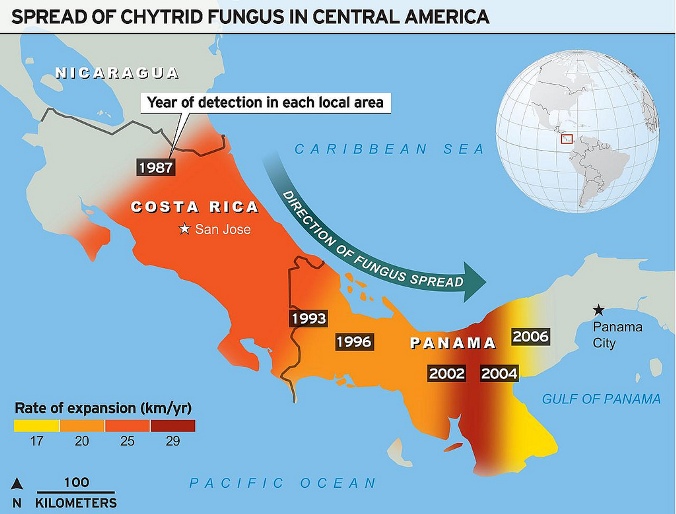Interactions
There are many organisms that play a large role in the life
of the Panamanian Golden Frog. Between being a predator to
organisms, being prey of organisms, and partaking in
symbiotic relationships with yet more organisms, the Panamanian
Golden
Frog finds itself in the
 company of other creatures every minute
of every day.
company of other creatures every minute
of every day.
The Panamanian Golden Frog has a predatory relationship to many small insects and other invertebrates in the tropical forests of Panama. It prefers to snack on these small invertebrates as its main source of nutrition. However, as previously mentioned, most of the Panamanian Golden Frog population is now held in captivity meaning its main meals consist of crickets and fruit flies. Quite boring for the frogs!
On the opposing side of the spectrum, the Panamanian Golden Frog's main threat of existence is the chytrid fungus known as Batrachochytrium dendrobatidis. This chytrid fungus is effective at killing the Panamanian Golden Frog because of the design of the frog's respiratory system. Most frogs, including Atelopus zeteki, breathe through their skin as well as their oral cavity. Batrachochytrium dendrobatidis is a fungus that inhabits the dermal layer of the frog and effectively cuts off all gas exchange that takes place in the frog's skin; a process known as chytridiomycosis. Once the fungus is fully established in the skin of the frog, the frog is essentially suffocated because it is unable to get enough oxygen through its oral cavity. Hence, the current situation of critical endangerment for the Panamanian Golden Frog and many other frogs across the world such as Rana catesbeiana, also known as the American Bullfrog. Below is a map of how the chytrid fungus is spreading across Panama.
 Another
relationship that the Panamanian Golden Frog participates in and is not
fully understood is their predicted mutualistic relationship with
bacteria that secrete saxitoxins. Because the structure of the
toxin produced by Atelopus zeteki is extremely unique among
amphibians, scientists believe the frogs must contain bacteria that
help in the secretion of their saxitoxin-analog, zetekitoxin AB.
There is still much more research to be conducted in this area of
the frog's life. Shown to the right is the basic structure of
a saxitoxin.
Another
relationship that the Panamanian Golden Frog participates in and is not
fully understood is their predicted mutualistic relationship with
bacteria that secrete saxitoxins. Because the structure of the
toxin produced by Atelopus zeteki is extremely unique among
amphibians, scientists believe the frogs must contain bacteria that
help in the secretion of their saxitoxin-analog, zetekitoxin AB.
There is still much more research to be conducted in this area of
the frog's life. Shown to the right is the basic structure of
a saxitoxin.
 One relationship that Atelopus zeteki participates in,
willing or not, and is often overlooked when thinking of
interactions is the organism's relationship with humans. We
must not forget that, we too, are organisms that affect the lives of
countless other organisms around the world, Panamanian Golden Frogs being
no exception. This relationship could be classified as a mutualistic relationship in a sense due to the fact that humans have
helped the frogs to remain in existence by bringing them into
captivity and, in turn, we get to gain knowledge about these frogs
and appreciate a higher degree of organismal
diversity; an aspect of this world that allows for no second
chances.
One relationship that Atelopus zeteki participates in,
willing or not, and is often overlooked when thinking of
interactions is the organism's relationship with humans. We
must not forget that, we too, are organisms that affect the lives of
countless other organisms around the world, Panamanian Golden Frogs being
no exception. This relationship could be classified as a mutualistic relationship in a sense due to the fact that humans have
helped the frogs to remain in existence by bringing them into
captivity and, in turn, we get to gain knowledge about these frogs
and appreciate a higher degree of organismal
diversity; an aspect of this world that allows for no second
chances.
Courtesy of Brian Gratwicke
www.amphibianrescue.org
Note: Unless labeled, all images used under public permission.
To continue on to the Panamanian Golden Frog's facts, click here.
Are you lost? Go back HOME.

